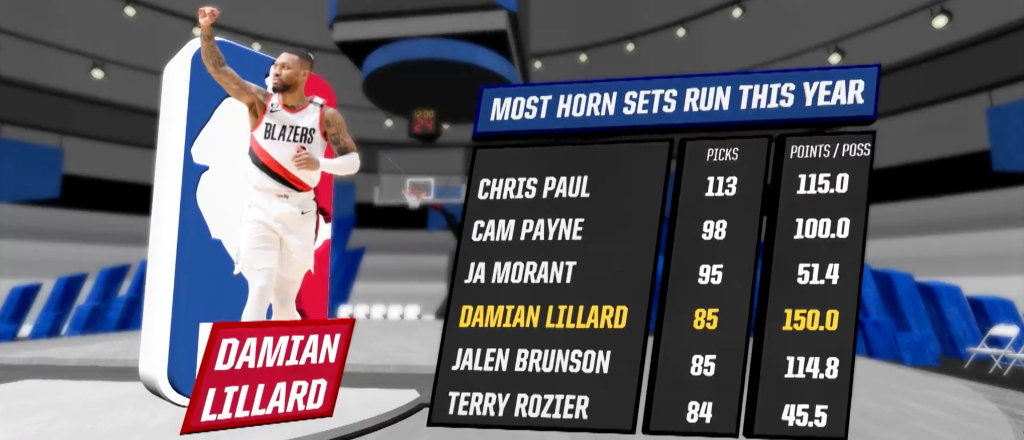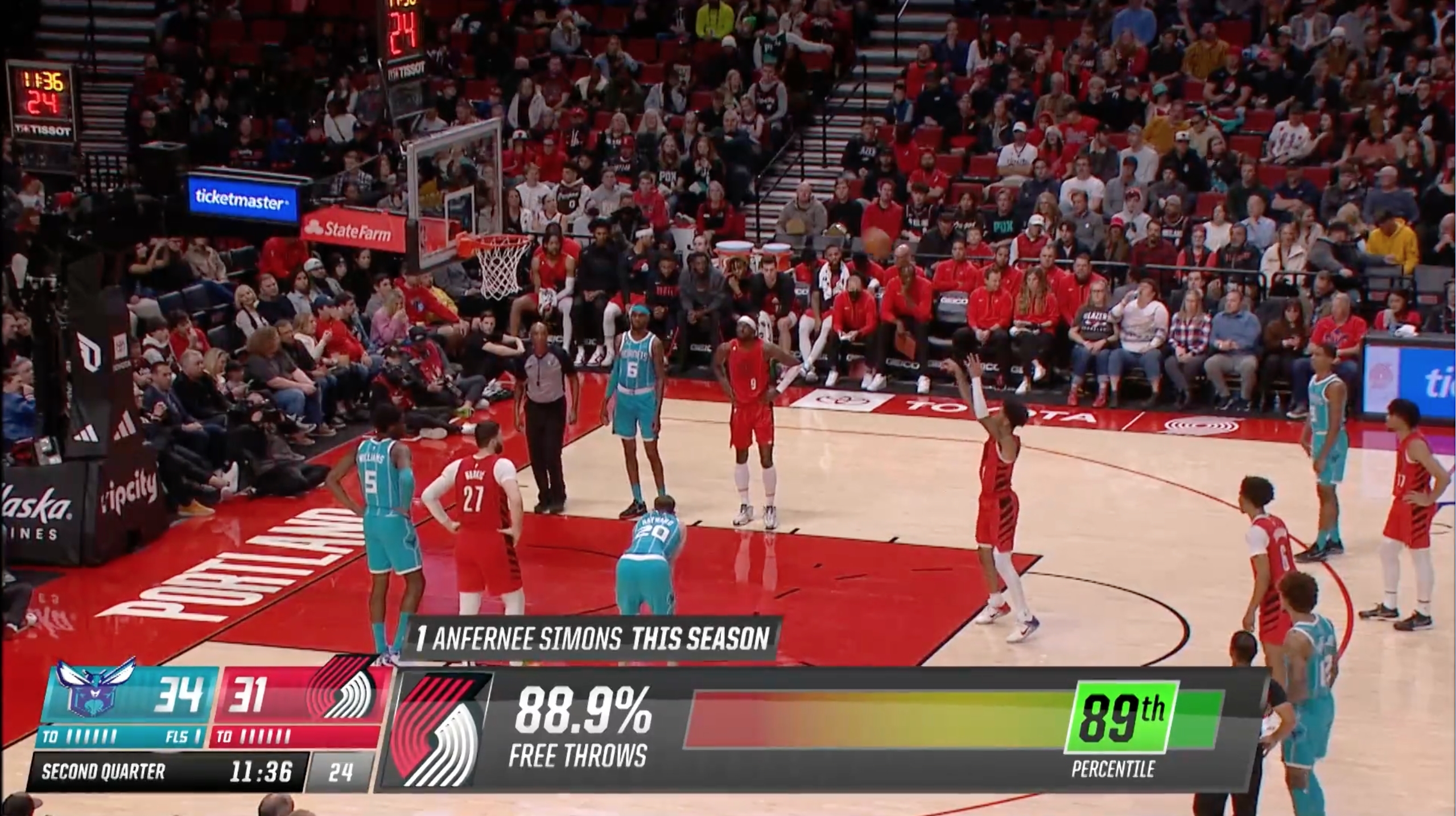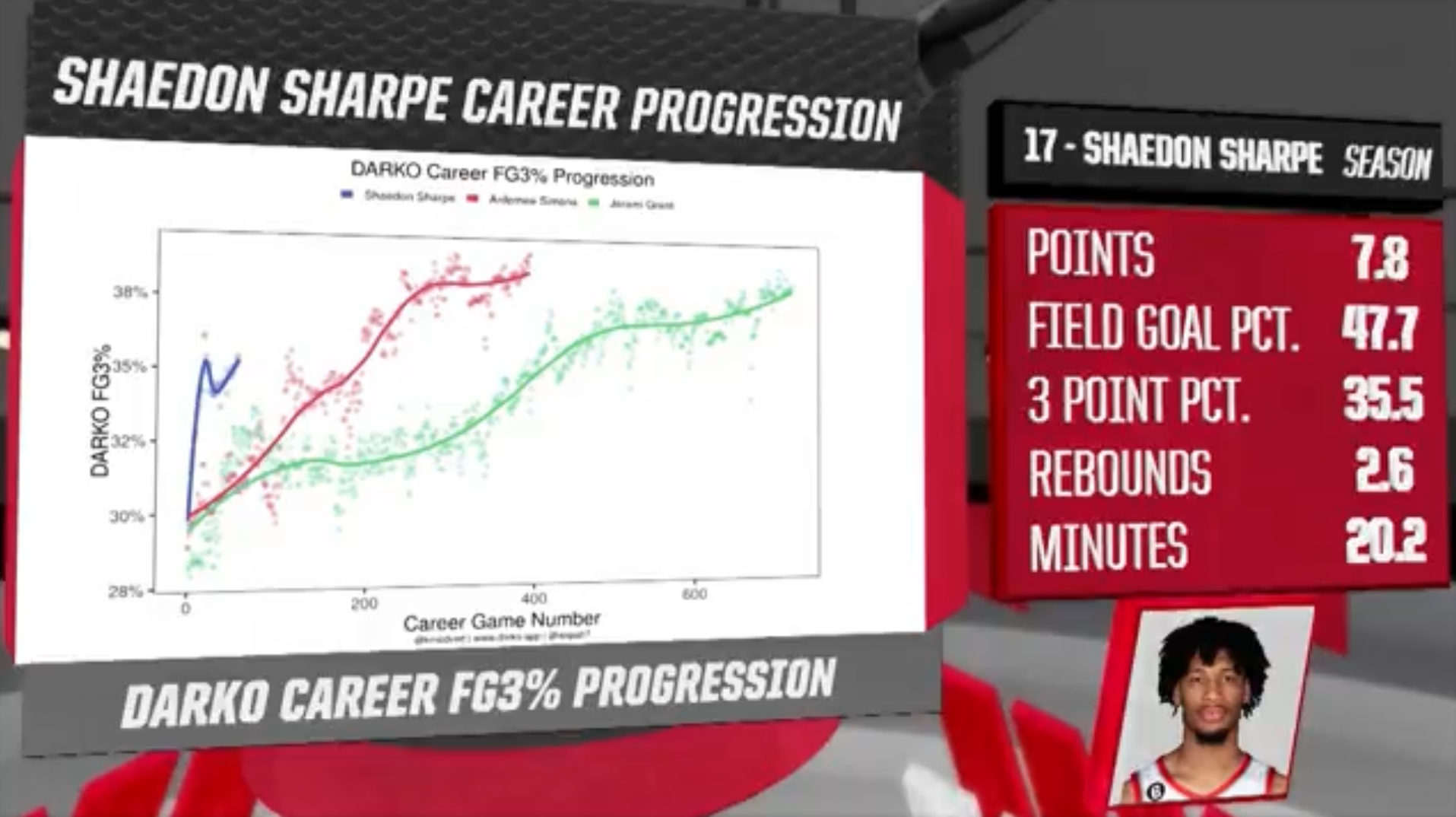
Early in the third quarter of a mid-January game between the Portland Trail Blazers and Cleveland Cavaliers, Blazers play-by-play announcer Kevin Calabro set the stage for a third member of the broadcast crew to join on-air, someone other than sideline reporter Brooke Olzendam.
“Cory Jez with us here tonight,” Calabro says. “Jez, live at Moda, with the numbers!”
As Donovan Mitchell shot free throws, Jez, the broadcast’s Analytics Insider, slid onto the bottom of the screen. Amid one of Damian Lillard’s more dominant showings of the season, Jez recited how many pick-and-rolls Lillard had run to that point in the game (24) and how many points per 100 possessions Portland was generating on those opportunities (133).
In his first season as part of the Blazers’ crew, Jez holds a mantle as the lone Analytics Insider across all 30 NBA broadcasts. His title is legitimately unique. The broadcast has a deal with Second Spectrum, which enables Jez to share statistical insights like the ones mentioned above and quantify what everyone is watching. The type of information ranges from pick-and-roll production to points per possession against zone defenses to catch-and-shoot numbers, all drawn from the game occurring in the present moment.
“It’s so helpful to the listener or to the viewer to be able to quantify actions,” says Michael Holton, Television Studio Analyst. “Cory helps us with data that quantifies actions.”
Lillard dropped 50 points on 28 shots against a top-three defense and eviscerated the varying modes of pick-and-roll coverage thrown his direction. Anyone tuned in witnessed his vibrant and prolific outing. Jez’s contributions were merely a blend of the eye test and the analytics.

“I really think the goal is just give these fans an added layer of insight to how their team is performing, why they’re performing, why they’re doing what they’re doing, and put it in the appropriate context,” Jez says. “At the end of the day, analytics is a decision support mechanism.”
Blazers ownership, President of Business Operations Dewayne Hankins, and the broadcast department went through an assessment of the “landscape of the industry” last spring. The organization wanted to “heighten the production values” and distinguish themselves from other telecasts around the league. Access and connectivity defined their vision for an amended broadcast. Inspiration for Jez’s job arose from national feeds, which periodically incorporate rules experts and former referees to share a credible perspective during critical or contentious calls and replays.
“That really made us think, well, what if we had a statistical, analytical person that would give us that information? Again, on a local level, no one’s doing it,” says Jeff Curtin, Director of Broadcasting. “Yeah, it was a risk. But it’s something that was, we’ve always been supported by ownership. It’s like, just try some ideas. If they don’t work, we’ll stop doing them. But, I think we found a gem with Cory Jez.”
Jez’s arrival is not the only change to the broadcast, either. An array of players have been mic’d up during games, including Lillard and Drew Eubanks. Interactive polls for fans are a popular feature. Graphics illuminating advanced data pop up throughout every broadcast. A couple of people were hired to join the production team, as well as a graphic designer who brings to life many of the statistics Jez shares. Everything is geared to maximizing the viewing experience for fans.
“For them to go, ‘Boy, this Portland telecast is something really special,’” Curtin says.
Jez’s role being unprecedented around the league elongated and complicated the hiring process a bit. There was no directory they could locate to guide them. They couldn’t inquire with another broadcast team for the position. They scoured Twitter, quickly realized the sports analytics community is quite well-connected and branched out from there.
At some point, Ben Falk, owner of Cleaning The Glass and former Analytics Manager for the Blazers, reached out to Jez, passed along the fact Portland was searching for someone to fill the gig, and said Jez’s name came to mind. The goal was always to hire an analytically savvy person first and develop them as an adept broadcaster over time. Jez fit the mold. His assimilation was eased by the familiarity shared among other on-air members in Calabro, Olzendam, Holton, and Lamar Hurd, all of whom tout more than half a decade of experiencing working Blazers broadcasts.
“It’s been quite an adjustment for me, frankly. I am a fish out of water and just trying to keep my head afloat with the broadcast stuff,” Jez says. “I think that’s probably part of the reason this has been, if folks wanna deem it successful thus far, is really due to Kevin, Lamar and Brooke, Michael, Francis [Williams], the studio folks, and everybody behind the scenes. I just have to show up and talk about the stuff that I know, and they make it really easy for me to do that.”
Jez’s preparation prior to and during games is rather extensive. He approaches his job much the same way he did as Director of Basketball Analytics with the Jazz when he helped prime assistant coaches for upcoming opponents by trying to answer these questions while observing film and sifting through data: Who does what? What stands out? What are their trends?

On Second Spectrum, he watches a slew of offensive and defensive possessions of Portland’s next matchup and notes different lineups, rotations, schemes, and preeminent players. Then, he supplements the eye test with information from Second Spectrum and Cleaning The Glass to establish the theme of his first couple on-air hits.
Usually, his pre-game and first quarter segments are scripted ahead of time. He’s also collaborating with the graphics design team before games to determine how the numbers he’s referencing or discovering can best be displayed visually and enhance the stories being told. Even if he’s not mentioning them during his sidebars, the graphics stem from his scrupulous research.
While the action unfolds, Jez is watching on two feeds. One is live and the other is on a ~10-second delay to let him pick up on anything he may miss initially. He’s tracking real-time data via Second Spectrum and Cleaning The Glass on two other screens. TV timeouts are his solace and afford him the bandwidth to ready for another segment as he researches what he’s seeing on the floor.
“I’m really read and reacting to the game,” Jez says. “Early on in the season, I was so concerned with staying eyes locked into the camera and not breaking eye contact. So, we kind of decided, like, you’re the stats guy, you’re looking off to your number. I think it kind of works within the production of what we’re doing. So, we’ve gotten a little more comfortable looking off screen to grab a number. But it’s pretty hectic.”
After receiving degrees from Virginia Tech and Georgia Tech, Jez’s career began outside of the sports sector, where he cycled through jobs in data science, consulting, and data analysis, which he described as “boring shit.” An accomplished golfer who still participates competitively on the national stage, he also grew up around basketball, though JV high school basketball was the precipice of his hoops career. His father, Paul Jez, held the all-time assists record at Division III Randolph-Macon for more than 40 years and coached at VCU in the 1980s and 1990s.
When the Moneyball Era exploded early last decade, Jez realized being paid to watch sports was a possibility. He already tuned into League Pass six nights a week and considered himself an amateur Draft analyst and salary cap nerd. Maybe, he thought, he could parlay his deep-rooted passion for basketball, experience with data science, and proficiency with SQL and Python — two prominent softwares in the data science world — to enter the sports sphere as a full-time career.
“It was really just probably right place, right time,” he says.
Since then, he’s been employed by the Utah Jazz and Washington Wizards in their analytics departments, founded his own golf analytics company, and worked for Austin FC of Major League Soccer. Periodically, he still consults with Austin FC and professionals on the PGA Tour.
When he connected with the Blazers this past summer, roughly 18 months removed from working in the NBA in a professional setting, he knew he missed the league and welcomed reigniting his career in a divergent role, this one public-facing. Whether it’s intentional or through osmosis, he’s noticed the entire broadcast team progressively involve advanced data into their analysis and thought-processes over the course of the season. Those who conduct research behind the scenes for folks like Calabaro and Hurd are relying on Second Spectrum or Cleaning The Glass instead of more antiquated data resources.
“Cory has just been fantastic with our team and he just knows the subject so well. He’s educating my team this season because we came in not knowing a lot,” Curtin says. “He’s selling stories, just like Brooke does, just like Lamar does.”
For instance, last month, the Atlanta Hawks were in town. At that time, the Hawks led the NBA in field goals made per game, but were just 21st in offensive rating. The broadcast explained why the latter number can be misleading with regard to evaluating offensive output.
“It was a slice of genius to bring Cory on board,” Holton says. “I like the human element of still being able to unpack basketball from the eye test perspective and I love the marriage of the two things. I think it’s working extremely well.”
